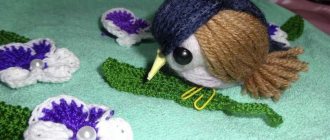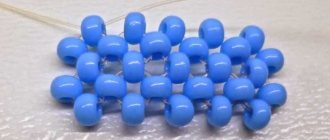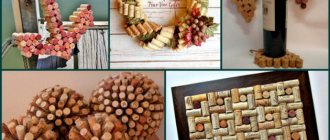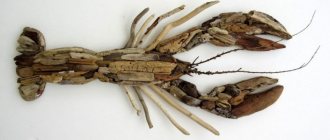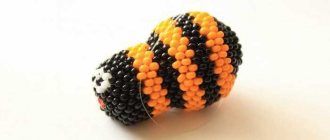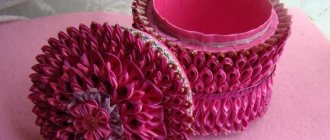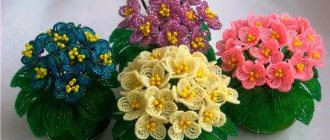Preparing for weaving
Working on creating a universal bracelet requires a well-lit room.
In addition to this, the master needs something else:
- Multi-colored threads.
- Scissors.
- Pillow.
- Pins.
- Glue.
- Lighter.
- Ruler.
If you don't have a work cushion, use a regular sofa cushion. A tablet with a special fastening perfectly fixes the threads. Next we will discuss how to weave baubles from threads for beginners.
Choosing floss color
Since floss baubles have long been considered talismans, their colors are important. When planning to make a bracelet with your own hands as a gift to a person, you need to take into account not only his favorite colors, but also the emotions or wishes that you want to convey to him - in this weaving a bauble is similar to creating a mandala, in which the palette used is also important. All colors except black carry exclusively positive emotions. Even some color combinations have meanings, so experienced fenco weavers sometimes make training videos to make it easier for novice colleagues to choose the color of threads.
Securing threads
Weaving baubles from threads involves certain product models and manufacturing methods. The key point is to secure the threads. Let's consider several ways.
1st method
Clasp at the end of the bracelet:
- Cut and divide the threads in half.
- Fasten the pin to the pillow, leaving 2-3 mm of fabric to grip. This ensures the free access required for the width of the product.
- At the indentation place we type a number of nodes. Fold the thread in half and get a loop.
- Then it is thrown over the needle and placed on the pillow. Next, we tighten the end of the strand into a knot.
- One thread is thrown to the top, and the other remains below.
- Other threads are attached in a similar sequence.
There are two types of fasteners: tie and buttonhole. The threads are deposited 7-8 cm from the edge. In the second case, weaving occurs on the top row of threads. Then the eye of the fastener is formed and secured to a similar pin.
2nd method
This method is used when working with a pin:
- We determine the length and amount of material.
- We fasten the main thread.
- With one thread we retreat from the edge by 8-10 cm. Then it bends from the bottom up. The short part ends up on top of the warp and becomes a working thread.
- The short strand is wound behind the long one. It is wound in advance by the base, and then thrown over it and passed through the loop.
- Next the knot is tightened.
- We move the working thread to the top.
- We fasten all other threads in the same way.
- After collecting and laying all the strands on top, a loose knot is made and secured with a pin.
- The pins that fixed the base are removed and moved to the collected threads.
3rd method
Overlay process:
- We measure the required number of strands and cut.
- We arrange them on the table according to color (we start from the weaving pattern).
- Secure with tape 10 cm from the edge.
- All threads are tied near the clamp. This way they won't pop out.
At first glance, this knitting method seems simple. However, there are some disadvantages that make it difficult for beginners.
- Without rigid fastening it is difficult to weave the first rows evenly.
- Scotch tape does not hold synthetic and waxed fabrics well.
- The paper clip cannot hold the threads properly.
To solve this problem, you should use a wooden ruler located between the clamp and the threads.
Floss baubles
Baubles greatly decorate women's hands, and homemade accessories - even more so, because they are unique and emphasize the individuality of the hostess. The simplest options also look great - it all depends on their execution. You can make amazing baubles from floss with your own hands that will look really cool!
Pay attention to the inexpensive set of 8 skeins of floss on AliExpress. The desired color must be indicated in the message with your order. You can read reviews and buy threads using this link.
We have put together several master classes for you, with which you will learn how to weave bracelets using the macrame technique from different types of threads. We will talk about thin and wide baubles: with or without inscriptions, with or without additional decor. Some weaving lessons will be useful for beginners (if you are one of those who have never made baubles from floss, this is for you), and experienced craftswomen will also like some of them. We hope that everyone will choose the right option for themselves.
A simple bauble for beginners
You can learn how to weave baubles from floss from this master class. Here you will need a thread of one (or two) colors and basic decor. A few minutes of free time - and the bracelet will be ready.
We cut off the thread, which when folded will be about 10 cm longer than your wrist. You can even longer - this will make it more convenient to weave. Fold the thread in half, leaving a small loop, and secure it to the table with a strip of thin tape. The second thread should be about 4-5 times longer. Place it under the main thread.
We form a loop on the left and pass the right thread into it. This is the first stitch traditionally used in macrame weaving. Tighten the knot.
Make a second loop on the other side. The weaving is the same here. Tighten the knot.
Now we repeat the steps one after another and weave exactly to the middle (determine the length of the future bauble in advance using your hand).
At this stage, you can add a bead or a beautiful decorative button to make the bracelet a little heavier, and at the same time make it more beautiful and interesting. Then we continue the usual weaving until the second end of the bauble.
At the end, add a small button with a beautiful decor so that the bauble is fastened with a loop.
Please note that we fasten it using the same threads with additional loops. Use a needle to pass the thread under the loop. Cut off the excess threads with wire cutters, and burn their ends with a lighter to form “knots”. Take precautions when working with fire!
A thin bauble made of floss with a small decorative element looks very beautiful both in a single color version and when combining two threads of contrasting colors. If you have mastered this master class, you will quickly master the rest. If you want to try something more challenging, see the step-by-step instructions below.
Weaving baubles using the oblique method
Perhaps these are the most popular baubles made from floss threads. They look quite difficult to make, but in reality this is not the case at all. With the help of this step-by-step instructions you will learn how to weave such baubles and will not get confused.
We will need 12 threads - each approximately 1 meter long. Take 2 threads of six different colors so that the pattern is visible and symmetrical. Position them in a mirror manner. Tie a knot at the top to connect them together. Secure the “tails” with tape on the table, a pin on any fabric, or a paper holder on a ruler.
Place the threads as far apart as possible and start weaving from the edge to your left. Take the outermost thread and the adjacent one. Pass the first thread under the second from the bottom and tighten the knot (as in the photo). Repeat the procedure to the very center, taking one thread after another without changing the main one. Then repeat the same with two strands of floss, which are located on the extreme side: exactly the same weaving pattern - to the center.
We need to weave so that eventually the outer threads move to the center of the bauble, and the inner threads to the outer edge. This means that we again weave the next row from the edge, but this time the main thread will be the one that was originally the penultimate one (orange in the photo).
The first rows will have to be constantly monitored so as not to mess anything up - constantly hold the bauble with your hands and weave slowly. Then the threads will line up on their own - you will only weave them according to a logical pattern.
This is how we get a kind of “Christmas tree”. During the process of weaving baubles, the threads will change places several times.
It is not at all necessary to make a bauble from threads of 6 colors - you can make a bracelet with oblique weaving and two colors. However, if you are a beginner, the first option will be preferable. Everything becomes easier if each new thread is a new color - you will intuitively feel how to weave them in the right order.
Straight weave baubles with patterns
You can make beautiful straight weave baubles with your own hands from two or more threads. Straight weaving is quite simple. Moreover, you can vary the width of the bracelet: it doesn’t make much difference whether you weave a thin bracelet or a very wide one, because the labor costs will be approximately the same.
To start weaving a straight bauble, you need to decide on its width and draw a preliminary diagram, marking the threads. You can immediately apply and think over any image and letters. Decide right away what color the pattern will be - for beginners it is better to take 2-3 types of floss and the simplest pattern.
Secure the threads to the cardboard using tape and a paper holder. Let's divide the threads into several categories to make it clearer:
- Main . It should be the same color as you want your future accessory to be. To put it simply, this is the background of the baubles. The main thread will be the longest, but don’t rush to measure it right away. It will be inconvenient to tinker with a five-meter floss - leave the thread directly in the finished spool and unwind it as needed.
- Auxiliary . This thread is responsible for the color of the design. Usually there are several of them, and they should not be too long: within a meter, plus or minus 20 cm. The consumption of the auxiliary thread will depend on the size and complexity of the pattern for the future bauble.
- Additional . There are usually several of them too. In this case, you need to choose floss of the colors that are needed for decoration and adding minor details. They are woven into the pattern only as needed, and the ends are cut off after the weaving is completed.
To weave a straight weave bauble with a pattern with your own hands, you need to choose a pattern. This is the first step. We offer you several options, but you can easily draw something yourself. To do this, take a notebook sheet in the squares and fill them with color so that you get one or another drawing. A filled cell corresponds to a knot of one color or another; empty cells correspond to the background (this is the main thread).
If there is an empty square in the diagram, make a knot with the floss of the main thread of the bauble and go through the row to the end. Then walk from the opposite edge in the opposite direction. As soon as you come across a knot of the color of the auxiliary thread, take floss of the corresponding color, and weave the rest of the row with the main one.
Try starting with something simple. You can easily make a straight weave using two colors of thread, adding just a few stitches with a contrasting color thread to create distinctive dots. However, you can immediately take on something complex.
Bonus: video master class
It is quite possible that you do not quite understand the patterns of weaving baubles with straight or oblique weaving. To make everything clearer, we invite you to watch this short video master class, which describes in detail how to make a bracelet from floss threads with your own hands. As an example, we chose a pattern for weaving a bauble with an inscription (bracelets with a name or quotes are very popular).
The instructions are very simple and understandable - even a beginner can master it. If you have any difficulties, try repeating this lesson, and then take on your own patterns.
This is just a small selection of patterns for weaving floss baubles for beginners, which are really easy to do with your own hands. Choose, learn, create. We hope you don't have any difficulties. At first everything may seem difficult, but later you will weave them very quickly - it takes practice. Good luck!
We recommend you watch: DIY stand for bracelets
Main nodes
What you need to know before making a thread bauble. There are three knots that are used in weaving. The knitting principle is the same everywhere. The weaving process uses a double knot: the first one is tightened tighter than the second one.
Left-handed or right-handed weaving is used in manufacturing. This fact should be taken into account when working on specific schemes.
Second method
Using this weaving pattern, you can knit a voluminous bauble from two threads (in the photo there are satin ribbons instead of threads), the thread should not be very thin , the pattern will be more clearly visible if the thread is thicker.
And the video will tell you about the pattern of crossing threads and the final result:
Tatting
- The thread is wound to the right from the base and circled over the top. Goes through the loop from below.
- We tighten one knot to the base.
- The second node is created in the same way. It comes in from below, circling the base and passing down through the loop.
- Unlike the first knot, the current one is not tightened so much.
The thread goes to the left and the right-hand weaving is mirrored. Following this direction is extremely important when weaving bracelets. In this way, the colored threads that form the pattern move to the place where they are needed to create a new row.
How to weave baubles with fringe?
One of the simplest options among the many patterns for weaving baubles. To make a bauble with fringe you will need several dozen pieces of thread up to 20 cm. For the base you will need 10 plain pieces.
- We lay out the warp threads and fasten them with adhesive tape or weights.
- We take the first colored thread and weave the first row with knots along the main threads. Before the first knot on the left, we leave a colored tip of 1.5-2 cm. At the end of the row we also leave a tip of 1.5-2 cm. We cut off the excess.
- Similarly, we weave many rows with different colored threads with small tails on both sides. The fringe length can be the same or different
- We tie the ends of a long bauble with knots or weave braids from the main threads. We get an adjustable bracelet.
Rep
- A thread comes from the right side and is drawn over the warp. Then from the bottom side it goes on top of itself.
- The first and second knots are tightened.
The left-hand weaving process is similar to the first. You can already start weaving simple baubles after mastering at least one rep knot. If you ignore the directions and braid the base with a rep knot, you get a spiral bracelet.
Next, we will discuss jewelry items for a hand bracelet.
What you need, what threads to choose
In order to make baubles for beginners, it is better to purchase floss. You can buy them at any craft store. They come in various colors and sizes. Each skein contains from 8 to 20 m of thread. They are all bright, rich, and there is even floss with a gradient effect, which is very popular now. The choice is so large that every needlewoman will be able to choose the appropriate option based on price, color and quality. Some types of baubles can be made from woolen, knitting threads
If you are not sure that you will succeed the first time and do not want to spend money, then you can try it on the threads that you have at home, for example, “iris” or “peony”.
Beads
Bracelets look great when complemented with beads or beads. Before creating a bauble, it is necessary to string decorating materials onto the thread used for weaving. Bead inserts are made in the middle of the bracelet, alternating or replacing nodes.
Patterns for weaving baubles
You can learn how to weave this or that bauble from the weaving diagram. To do this, you should learn to read them. First of all, you should understand that a bauble can weave both in a full cycle and in an incomplete one. This can be determined using the arrangement of threads: a complete cycle is characterized by the correct sequence of colors on both sides of the bracelet
In an incomplete cycle, the threads on the left and right will not match each other in color.
An example of a complete cycle is the very first version of weaving a bauble described above, in which, at the end of the pattern, its weaving begins again from the very beginning. In partial cycle patterns, you need to keep track of the sequence of the cycle, but ending the weave map will also mean returning to the beginning of the cycle.
In addition to different weaving cycles, there are patterns with paired and unpaired numbers of threads in the bundle.
Paired number of threads (6 gray and 6 yellow)
Paired number of threads (4 red and 4 white)
Unpaired number of threads (6 blue and 5 yellow)
Unpaired number of threads (5 white, 3 gray and 2 yellow)
Rhinestones, stones
We take a ready-made bauble and a chain of jewelry: rhinestones or stones on a sewn-on base. We use a needle with thread that matches the tone of the bracelet. Next you will need scissors and glue. Strips of rhinestones and stones are sewn onto the bracelet using small stitches.
Decorative fasteners
The traditional way of attaching baubles to your hand is to tie them in two knots (so as not to lose them). If desired, you can attach a clasp to the base of the woven bracelet and trim the “tails.” Advanced fencoweavers often make tricky clasps with their own hands, and although they are often impractical, just for fun, watch thematic tutorials and try it out.
A very simple and convenient fastener can be made in the form of a loop at the beginning of the weaving and sew on a button (or bead) at the end of the weaving. Let's look at the principle of creating such a fastener using a simple 12-thread pattern. It is necessary to cut not 12 pieces of floss 80 cm each, but 6 approximately 160 centimeters each. Fold them in half and make a small loop, take out one piece of floss in the color of the outer threads in the diagram and tie it in the middle of the other threads. Now use one end of the thread to tie neat knots around the remaining threads; with the second tip you need to do the same thing, but in the other direction. When the loop seems wide enough, it's time to start making the floss bracelet.
Chain
The chain looks unusual as a complementary element to the bracelet.
Making your own machine for weaving flowers
To make a machine (Tenerife) at home, you will need several materials from the following list:
- a piece of thick and dense cardboard;
- compass with pencil, ballpoint pen and ruler;
- a hacksaw with twelve pieces of nails.
Draw and cut out a circle from thick cardboard, and make a round hole in the center, as shown in the photo. Using a ruler, divide the workpiece into twelve equal parts, which are then numbered in order from one to twelve.
Nails should be driven in along the edges, visually separating the sectors. You can do it yourself, or ask your man, then the machine will probably turn out as needed. In the photo you can see how it will look after completion.
Using this template, which is shown in the picture, you can make completely different cardboard blanks.
Satin ribbons
The weaving principle is similar, but the knots remain in a free position.
- Making bracelets with your own hands is an exciting activity, but it requires perseverance and attentiveness.
- Create your own version of the bauble using different weaving techniques and adding various pieces of jewelry.
- Give a gift to your family or friends. Stand out from others with an exclusive symbol on your hand.
So, we figured out the topic - how to weave thread baubles for beginners. This craft perfectly reveals the creative potential of the manufacturer. When creating, leather cords, household ropes and even herbs are used.
Decorations can include stones, pendants, zippers, medallions, buttons, washers, nuts, flowers, bark, leaves, etc. This is a good opportunity to emphasize your own style, putting your whole soul into your work.
Some people like to insert short words to reveal the symbolic meaning of the bracelet. And other craftsmen like to decorate the product with complex patterns with additional decorating objects. How would you decorate your bracelet?
First way
You will need threads of two different, contrasting colors, with a length equal to the circumference of the wrist, plus an increase in the freedom of fit, ties and knots along the edges of the baubles, which will hold the two threads together, approximately 30-40 cm each.
You need to tie two threads together at one end with a knot, stretch the threads in different directions so that the knot is in the middle, then you can ask someone to help twist the threads of the bauble. One hook holds one end of the common thread, and the other holds the second end of the thread, and everyone begins to twist the thread in one direction and in the opposite direction, i.e. one person twists the thread towards himself, and the other - away from himself. The threads must be kept tight so that they later tangle together correctly and evenly. The next step is to take the knot with one hand, and the other ends of the thread together in the other hand and release. The ends of the threads will begin to twist together, you just need to adjust it a little later and finally tie a knot at the free ends. So a simple two-strand bauble is ready!
Related article: How to weave a figure on a hook from rubber bands: lumigurumi for beginners
The video material will add clarity to the creation of such a bauble:

